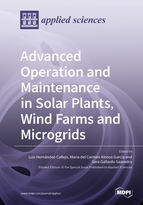Advanced Operation and Maintenance in Solar Plants, Wind Farms and Microgrids
A special issue of Applied Sciences (ISSN 2076-3417). This special issue belongs to the section "Energy Science and Technology".
Deadline for manuscript submissions: closed (31 March 2022) | Viewed by 49734
Special Issue Editors
Interests: energy; engineering; computer science; photovoltaic systems; microgrids; distributed generation; smart metering
Special Issues, Collections and Topics in MDPI journals
Interests: photovoltaic solar energy; characterization and modelling; degradation of PV modules and plants; accelerated testing; O&M of PV plants; renewable energies
Interests: renewable energies; photovoltaics; advanced maintenance; PV inspections; O&M; wind energy; smart cities
Special Issues, Collections and Topics in MDPI journals
Special Issue Information
Dear Colleagues,
The development of renewable generation plants and microgrids is a reality. Every day more facilities of this type are springing up, and their advance requires new research studies. Among renewable energy, solar plants (photovoltaic, thermal, and hybrid) and wind plants have had the greatest impact in recent years. With regard to microgrids, these scenarios are integrators of local generation sources (renewable or nonrenewable) and are facilities that promote energy sustainability.
In any case, both renewable generation plants and microgrids require technological development tools, mainly with regard to their operation and maintenance. Therefore, this SI calls for reviews, research articles, case studies, and technical notes on "Advanced Operation and Maintenance in Solar Plants, Wind Farms and Microgrids"
For solar plants, wind farms, and microgrids, the articles may focus on one of the following topics:
- Artificial intelligence and data mining;
- Simulations related to operation and maintenance;
- Development of software and/or SCADA for operation and maintenance;
- New development of sensors and hardware for application to operation and maintenance;
- Economic balances of the operation and maintenance;
- New operation and maintenance techniques;
- Hybrid photovoltaic and thermal systems;
- Storage for operation or maintenance.
Dr. Luis Hernández-Callejo
Dr. Maria del Carmen Alonso García
Dr. Sara Gallardo Saavedra
Guest Editors
Manuscript Submission Information
Manuscripts should be submitted online at www.mdpi.com by registering and logging in to this website. Once you are registered, click here to go to the submission form. Manuscripts can be submitted until the deadline. All submissions that pass pre-check are peer-reviewed. Accepted papers will be published continuously in the journal (as soon as accepted) and will be listed together on the special issue website. Research articles, review articles as well as short communications are invited. For planned papers, a title and short abstract (about 100 words) can be sent to the Editorial Office for announcement on this website.
Submitted manuscripts should not have been published previously, nor be under consideration for publication elsewhere (except conference proceedings papers). All manuscripts are thoroughly refereed through a single-blind peer-review process. A guide for authors and other relevant information for submission of manuscripts is available on the Instructions for Authors page. Applied Sciences is an international peer-reviewed open access semimonthly journal published by MDPI.
Please visit the Instructions for Authors page before submitting a manuscript. The Article Processing Charge (APC) for publication in this open access journal is 2400 CHF (Swiss Francs). Submitted papers should be well formatted and use good English. Authors may use MDPI's English editing service prior to publication or during author revisions.
Keywords
- Renewable energy power plants and microgrids
- Artificial intelligence and data mining
- Simulations related to operation and maintenance
- Development of software and/or SCADA for operation and maintenance
- New development of sensors and hardware for application to operation and maintenance
- Economic balances of the operation and maintenance
- New operation and maintenance techniques
- Hybrid photovoltaic and thermal systems
- Integration of electrical and thermal storage








